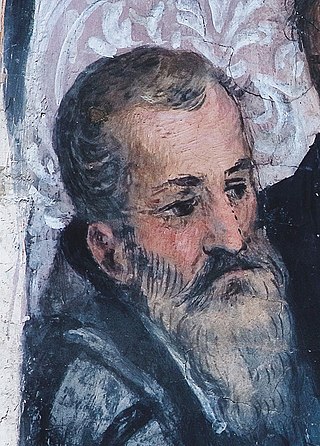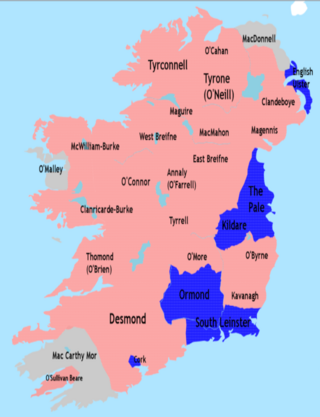
Hugh O'Neill, was an Irish Gaelic lord, Earl of Tyrone and was later created The Ó Néill Mór, Chief of the Name. O'Neill's career was played out against the background of the Tudor conquest of Ireland, and he is best known for leading a coalition of Irish clans during the Nine Years' War, the strongest threat to the House of Tudor in Ireland since the uprising of Silken Thomas against King Henry VIII.

Shane O'Neill was an Irish chieftain of the O'Neill dynasty of Ulster in the mid-16th century. Shane O'Neill's career was marked by his ambition to be the O'Neill—sovereign of the dominant O'Neill family of Tír Eoghain. This brought him into conflict with competing branches of the O'Neill family and with the English government in Ireland, who recognised a rival claim. Shane's support was considered worth gaining by the English even during the lifetime of his father Conn O'Neill, 1st Earl of Tyrone. But rejecting overtures from Thomas Radclyffe, 3rd Earl of Sussex, the lord deputy from 1556, Shane refused to help the English against the Scottish settlers on the coast of Antrim, allying himself for a short time instead with the MacDonnells, the most powerful of these settlers. Shane viewed the Scottish settlers as invaders, but decided to stay his hand against them with hopes of using them to strengthen his position with the English. However, tensions quickly boiled over and he declared war on the Scottish MacDonnell's defeating them at the Battle of Glentaisie despite the MacDonnells calling for reinforcements from Scotland. The Scottish MacDonnells would later assassinate Shane O'Neill and collect the bounty on his head.
Calvagh O'Donnell, eldest son of Manus O'Donnell, was an Irish King of Tyrconnell of the mid-16th century. He was king and chief of the O'Donnell dynasty based in Tyrconnell in western Ulster. He is best known for his conflict with Shane O'Neill - a dispute that involved the intervention of the English government in Ireland on Calvagh's side.
Manus O'Donnell was an Irish lord and son of Sir Hugh Dubh O'Donnell. He was an important member of the O'Donnell dynasty based in County Donegal in Ulster.

The O'Donnell dynasty were the dominant Irish clan of the kingdom of Tyrconnell, Ulster, in medieval Ireland.

The Nine Years' War, sometimes called Tyrone's Rebellion, took place in Ireland from 1593 to 1603. It was fought between an Irish confederation—led mainly by Hugh O'Neill of Tyrone and Hugh Roe O'Donnell of Tyrconnell—against English rule in Ireland, and was a response to the ongoing Tudor conquest of Ireland. The war began in Ulster and northern Connacht, but eventually engulfed the entire island. The Irish alliance won numerous victories against the English forces in Ireland, such as the Battle of Clontibret (1595) and the Battle of the Yellow Ford (1598), but the English won a pivotal victory against the alliance and their Spanish allies in the siege of Kinsale (1601–02). The war ended with the Treaty of Mellifont (1603). Many of the defeated northern lords left Ireland to seek support for a new uprising in the Flight of the Earls (1607), never to return. This marked the end of Gaelic Ireland and led to the Plantation of Ulster.

Clandeboye or Clannaboy was a kingdom of Gaelic Ireland, comprising what is now south County Antrim, north County Down, and the barony of Loughinsholin. The entity was relatively late in appearance and is associated partly with the Gaelic resurgence of the High Middle Ages. The O'Neill Clandeboy who reigned in the territory descended from Hugh Boy O'Neill, a king of Tyrone. His descendants took advantage of the demise of the Earldom of Ulster during the latter 14th century and seized vast portions of territory. Clandeboye's main seats of power were Shane's Castle and Castle Reagh.
The Battle of Glentaisie, was an Irish battle fought in the north of Ulster on 2 May 1565. The result was a victory for Shane O'Neill over the Clan MacDonald of Dunnyveg. The conflict was a part of the political and military struggle, involving the English and occasionally the Scots, for control of northern Ireland. Although the MacDonalds were a Scottish family, based principally on the island of Islay in the Hebrides, they had long been associated with the Gaelic polity rather than the Kingdom of Scotland.

Tír Eoghain, also known as Tyrone, was a kingdom and later earldom of Gaelic Ireland, comprising parts of present-day County Tyrone, County Armagh, County Londonderry and County Donegal (Raphoe). The kingdom represented the core homeland of the Cenél nEógain people of the Northern Uí Néill and although they ruled, there were smaller groups of other Gaels in the area. One part of the realm to the north-east broke away and expanded, becoming Clandeboye, ruled by a scion branch of the O'Neill dynasty. In one form or another, Tyrone existed for over a millennium. Its main capital was Dungannon, though kings were inaugurated at Tullyhogue Fort.
McCaul, also spelt MacCawell is an Irish surname, derived from the Gaelic Mac Cathmhaoil, meaning the "son of Cathmhaol", descendant of being implied. The name Cathmhaoil itself is derived from cath mhaol meaning "battle chief". The Mac Cathmhaoil were the leading family of Cenél Fearadhaigh, of the Uí Néill, and were based around Clogher in modern-day County Tyrone, Northern Ireland. They were one of the seven powerful septs that supported the O'Neills. Mac Cathmhaoil is now rare in Ulster as it has been Anglicised under various different forms such as, Campbell, McCawl, Caulfield, McCall, Alwell, Callwell, McCowell, McCuill, Howell, MacHall, and McQuade.
Finola MacDonald, styled after her marriage as Dame Finola Ó Domhnaill or Finola, Lady Ó Domhnaill, and better known by the Irish nickname Iníon Dubh, was queen consort of Tyrconnell. She was the daughter of Séamus Mac Dhòmhnaill, 6th Laird of Dunnyveg, and his wife, Lady Agnes MacDonald, and became the second wife of Sir Aodh mac Maghnusa Ó Domhnaill, king of Tyrconnell. She was the mother of eight children, including four sons. Her offspring included Hugh Roe O'Donnell, Rory, 1st Earl of Tyrconnell, and Cathbarr O'Donnell.
The McDonnells of Cnoc na Cloiche, were better known to the Irish as Mac Domhnáill Gallogáigh. They originated from the Kingdom of the Hebrides which became a part of Scotland with the 1266 Treaty of Perth and the signing of that treaty in 1312 by King Robert de Bruc. In the Kingdom of the Hebrides they were known as Clann-Somhaire taking the name under ancient Brehon Law from their common great-grandfather. In 1346 they became known as Clann- Domhnáill, taking the name of Somhairle's grandson Donnell who was their common great-grandfather at the time. This then became the clan's permanent name.

Porthall is a village and townland in County Donegal, Ireland. The village is located on the west bank of the River Foyle, in The Laggan district of East Donegal, on the R265 road. The nearest town is Lifford, the county town.
Sir Hugh McManus O'Donnell was an Irish Gaelic lord. He was The O'Donnell of his clan, and king of Tyrconnell in medieval Ireland.

The history of the Bissett family in Ireland can be studied independently from that of the originally identical family in Scotland, because of their unique experience following their arrival in Ulster in the early or mid-13th century. Here, while still remaining involved in Scottish affairs, the Bissetts would establish themselves as the Lords of the Glens of Antrim and quickly become equally, then eventually more involved in the politics of the Irish province, becoming among the most Gaelicised of all the so-called Anglo-Norman families in Ireland. The heads of the leading branch of the family soon adopted the Gaelic lineage style Mac Eoin Bissett, by which they are known in the Irish annals, and which translates as "Son/Descendant of John Byset", after a prominent ancestor born in Scotland. In a number of English and Anglo-Norman sources the same head of the family is referred to as the Baron Bissett, also with variants.
The Battle of Binnion Hill was fought in 1557 when John O’Neill, the Grandson of Con O’Neill assembled an army to attack Tirconnell, modern day County Donegal. O’Neill’s plan was to defeat Manus O'Donnell from the Kinel-Connell and thus be the only King in Ulster.
The Cenél nEógain or Kinel-Owen are a branch of the Northern Uí Néill, who claim descent from Eógan mac Néill, son of Niall of the Nine Hostages. Originally their power-base was in Inishowen, with their capital at Ailech, in modern-day County Donegal in what is now the west of Ulster. Under pressure from the Cenél Conaill, they gradually spread their influence eastwards into modern counties Tyrone and Londonderry, pushing aside the Cruithin east of the River Bann, and encroaching on the Airgiallan tribes west of Lough Neagh. By the 11th century their power-base had moved from Ailech to Tullyhogue outside Cookstown, County Tyrone. By the 12th century the Cenél Conaill conquered Inishowen; however, it mattered little to the Cenél nEóghain as they had established a powerful over-kingdom in the east that had become known as Tír Eoghain, or the "Land of Owen", preserved in the modern-day name of County Tyrone.
Sir Hugh Dubh O'Donnell was a leading figure in Gaelic Ireland during the Tudor era. He was part of the ruling O'Donnell dynasty of Tyrconnell. In Ulster Irish, Sir Hugh Dubh is pronounced as 'Sir Hugh Doov.
The Battle of Doire Leathan took place on 14 September 1590 at Doire Leathan, a townland and hamlet located between Kilcar and Carrick in south-western County Donegal in Ulster, Ireland. Derrylahan is on the eastern shores of Teelin Bay, being just across from the village of Teelin. The battle was part of the ongoing succession dispute for the leadership of the Gaelic lordship of O'Donnell. A combined force of Irish clans and Scottish Redshank mercenaries hired by Iníon Dubh defeated and killed Sir Domhnall Ó Domhnaill. The Tanist of Tír Conaill, Sir Domhnall's younger half-brother and Iníon Dubh's son, Red Hugh O'Donnell, was still imprisoned in Dublin Castle, but later rose following a subsequent escape to lead Clan O'Donnell and was a prominent figure during the Nine Years War.

Tirhugh is a barony in County Donegal, Ireland. Baronies were mainly cadastral rather than administrative units. They acquired modest local taxation and spending functions in the 19th century before being superseded by the Local Government (Ireland) Act 1898.







